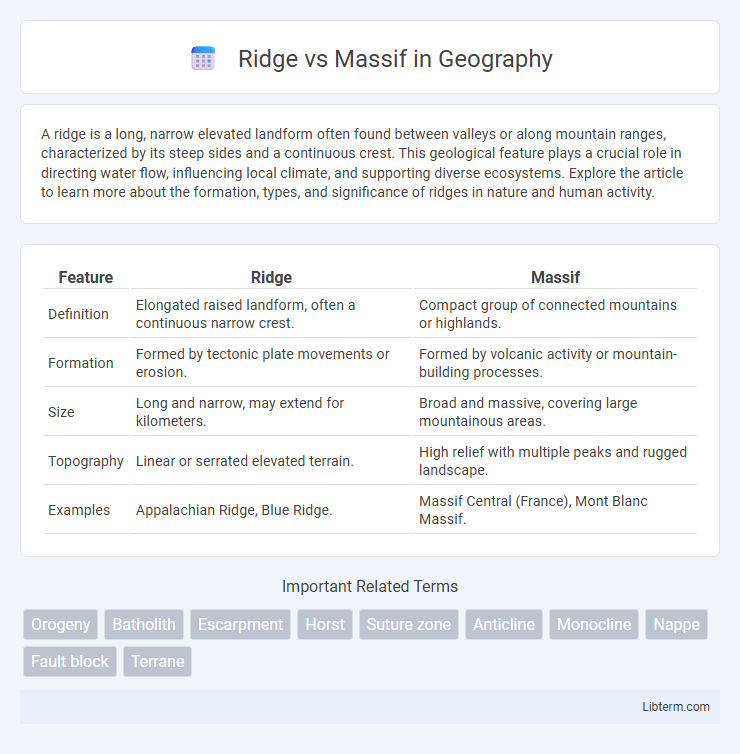A ridge is a long, narrow elevated landform often found between valleys or along mountain ranges, characterized by its steep sides and a continuous crest. This geological feature plays a crucial role in directing water flow, influencing local climate, and supporting diverse ecosystems. Explore the article to learn more about the formation, types, and significance of ridges in nature and human activity.
Table of Comparison
| Feature | Ridge | Massif |
|---|---|---|
| Definition | Elongated raised landform, often a continuous narrow crest. | Compact group of connected mountains or highlands. |
| Formation | Formed by tectonic plate movements or erosion. | Formed by volcanic activity or mountain-building processes. |
| Size | Long and narrow, may extend for kilometers. | Broad and massive, covering large mountainous areas. |
| Topography | Linear or serrated elevated terrain. | High relief with multiple peaks and rugged landscape. |
| Examples | Appalachian Ridge, Blue Ridge. | Massif Central (France), Mont Blanc Massif. |
Introduction to Ridges and Massifs
Ridges and massifs are fundamental geological structures formed by tectonic processes, with ridges typically representing elongated, narrow elevations often found at plate boundaries, such as mid-ocean ridges where seafloor spreading occurs. Massifs are compact, raised blocks of the Earth's crust bounded by faults, commonly associated with mountainous regions like the Massif Central in France or the Harz Massif in Germany. Understanding the distinct formation, composition, and spatial characteristics of ridges and massifs is essential for interpreting regional geology and tectonic history.
Defining Ridges: Key Characteristics
Ridges are elongated, narrow elevations of land characterized by a continuous crest, often formed through tectonic activity or erosion processes. They typically exhibit steep sides and extend over long distances, creating natural boundaries and influencing watershed patterns. Unlike massifs, ridges are linear features that connect peaks or high points, emphasizing their prominent role in defining mountainous terrains.
Understanding Massifs: Main Features
Massifs are large, coherent blocks of the earth's crust, characterized by tectonic stability and minimal deformation compared to surrounding regions. Unlike ridges, which are elongated and often formed by volcanic or tectonic activity, massifs are typically composed of ancient, crystalline rocks and can form prominent highland areas. Their structural integrity and resistance to erosion make massifs significant geological formations for studying earth's crustal dynamics and tectonic history.
Geological Formation of Ridges
Ridges form through tectonic plate movements that cause uplift and folding of the Earth's crust, resulting in elongated elevations with sharp crests and steep sides. These geological features often arise from faulting and erosion processes, distinguishing them from massifs, which are compact, stable blocks of crust uplifted as a single unit. Ridges commonly appear along mountain ranges and tectonic boundaries where compressional forces dominate.
Geological Formation of Massifs
Massifs are large sections of the Earth's crust that have remained intact through tectonic activity, often characterized by their rigid, block-like structure formed by ancient uplift and erosion processes. Unlike ridges, which are typically elongated and formed by tectonic plate divergence or volcanic activity, massifs result from the consolidation of crystalline rocks and deep crustal processes during mountain-building events known as orogenies. These formations commonly expose complex metamorphic and igneous rock sequences, providing valuable insights into the Earth's geological history and crustal deformation.
Differences in Structure and Shape
A ridge is a long, narrow elevated landform characterized by a continuous crest, often formed by the folding or faulting of the Earth's crust, whereas a massif is a compact, massive block of mountains or a large section of the crust uplifted as a whole. Ridges typically exhibit elongated, linear shapes with relatively uniform height, while massifs possess irregular, bulky structures with multiple peaks and complex internal geology. The structural difference lies in ridges representing linear tectonic features, whereas massifs form as rigid blocks sustaining more substantial vertical relief and intricate rock formations.
Examples of Famous Ridges Worldwide
Famous mountain ridges such as the Appalachian Trail in the United States and the Great Dividing Range in Australia demonstrate the distinctive linear and elevated nature of ridges, often extending over hundreds of miles. In contrast, massifs like the Mont Blanc Massif in the Alps and the Massif Central in France represent compact, massive mountainous blocks characterized by complex geology and high peaks. These examples highlight that ridges emphasize elongated, narrow formations while massifs showcase bulky, extensive elevated regions.
Notable Massifs Around the Globe
Prominent massifs such as the Mont Blanc Massif in the Alps, the Massif Central in France, and the Harz Mountains in Germany exemplify the geological significance of these compact mountainous regions formed by tectonic forces. Unlike elongated ridges, massifs often feature complex rock structures and serve as key biodiversity hotspots with unique flora and fauna. These notable massifs attract geologists and ecotourists alike due to their distinct topography and ecological importance.
Importance of Ridges and Massifs in Ecology
Ridges create unique microclimates and serve as vital corridors for species migration, supporting biodiversity by connecting fragmented habitats. Massifs act as ecological refuges with stable climates that preserve endemic species and maintain genetic diversity. Both landforms play crucial roles in watershed regulation, soil stability, and sustaining ecosystem services.
Ridge vs Massif: Summary and Comparison
Ridges are elongated, narrow landforms typically formed by tectonic activity or erosion, characterized by a continuous crest line, whereas massifs are compact, large groups of connected mountains or rock formations often resulting from uplift and folding. While ridges emphasize linear geographical features, massifs represent substantial, consolidated mountainous blocks with complex internal structures. Both features influence regional topography and climate patterns but differ significantly in scale, formation processes, and geological composition.
Ridge Infographic

 libterm.com
libterm.com